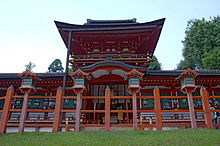Kasuga-taisha
| Kasuga-taisha 春日大社 | |
|---|---|
 The middle gate and hall | |
| Width | 280 |
| Website | |
| http://www.kasugataisha.or.jp/ | |
Kasuga Grand Shrine (春日大社, Kasuga-taisha) is a Shinto shrine in the city of Nara, in Nara Prefecture, Japan.[1] Established in 768 A.D. and rebuilt several times over the centuries, it is the shrine of the Fujiwara family. The interior is famous for its many bronze lanterns, as well as the many stone lanterns that lead up the shrine.
The architectural style Kasuga-zukuri takes its name from Kasuga Shrine's honden (sanctuary).
Kasuga Shrine, and the Kasugayama Primeval Forest near it, are registered as a UNESCO World Heritage Site as part of the "Historic Monuments of Ancient Nara".
The path to Kasuga Shrine passes through Deer Park (where tame deer roam free). Over a thousand stone lanterns line the way. The Man'yo Botanical Garden, Nara is adjacent to the shrine.
History
The shrine became the object of Imperial patronage during the early Heian period.[2] In 965, Emperor Murakami ordered that Imperial messengers were sent to report important events to the guardian kami of Japan. These heihaku were initially presented to 16 shrines including the Tatsuta Shrine.[3]
From 1871 through 1946, Kasuga Shrine was officially designated one of the Kanpei-taisha (官幣大社), meaning that it stood in the first rank of government supported shrines. [4]
Festivals
During the festivals of Setsubun Mantoro (February 2-4) and Obon Mantoro (August 14-15), the thousands shrine lanterns of Kasuga-taisha are all lit at once.[5]
March 13 is the Kasuga Matsuri ("Monkey Festival"), which features gagaku and bugaku dance performances.[5]
Images
-
Chakutoden
-
Kurumayadori
-
Minamimon
-
Sakadono
-
Heiden, Buden
-
Keishoden
-
A smaller enclave
-
Lanterns
-
Lanterns
-
Bronze lanterns
-
Stone lantern leading up to shrine framing a Nara Park deer
-
Tying Omikuji at Kasuga Shrine
-
Path leading up to the shrine, braced by rows of stone lanterns
-
Kasuga stone lantern presented in 1997 to Nara sister city, Canberra, Australian Capital Territory
-
A "breast shrine" at the Kasuga Shrine walk decked with Ema plaques
See also
- List of Shinto shrines
- Twenty-Two Shrines
- List of National Treasures of Japan (crafts-others)
- List of National Treasures of Japan (crafts-swords)
- List of National Treasures of Japan (shrines)
- Deer (mythology)
- Modern system of ranked Shinto Shrines
- Kasuga Maru
- List of Special Places of Scenic Beauty, Special Historic Sites and Special Natural Monuments
Notes
- ^ Richard, Ponsonby-Fane. (1964) Visiting Famous Shrines in Japan, pp. 221-251.
- ^ Breen, John et al. (2000). Shinto in History: Ways of the Kami, pp. 74-75.
- ^ Ponsonby-Fane, Richard. (1962). Studies in Shinto and Shrines, pp. 116-117.
- ^ Ponsonby-Fane, Richard. (1959). The Imperial House of Japan, pp. 124.
- ^ a b "Kasuga Taisha". Hattori Foundation (est.1919) - The Yamasa Institute. Retrieved March 12, 2010.
References
- Breen, John and Mark Teeuwen. (2000). Shinto in History: Ways of the Kami. Honolulu: University of Hawaii Press. 10-ISBN 0-824-82363-X; 13-ISBN 978-0-824-82363-4
- Ponsonby-Fane, Richard Arthur Brabazon. (1962). Studies in Shinto and Shrines. Kyoto: Ponsonby Memorial Society. OCLC 399449
- ____________. (1959). The Imperial House of Japan. Kyoto: Ponsonby Memorial Society. OCLC 194887
- ____________. (1964). Visiting Famous Shrines in Japan. Kyoto: Ponsonby-Fane Memorial Society. OCLC 1030156
External links
- Official site in Japanese
- Japan Guide
- New York Public Library Digital Gallery, early photograph of entrance to Kasuga Shrine
- National Diet Library: photo, 1913
- National Archives of Japan: Kasugashinkozu, scroll showing annual festival at Nara Kasuga Grand Shrine (Edo period)
















